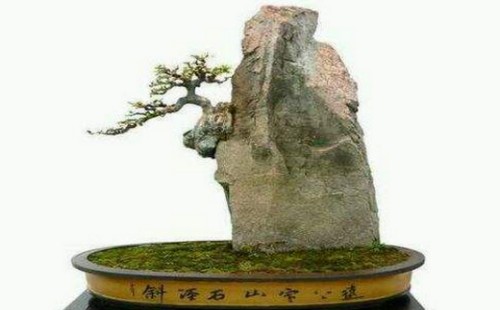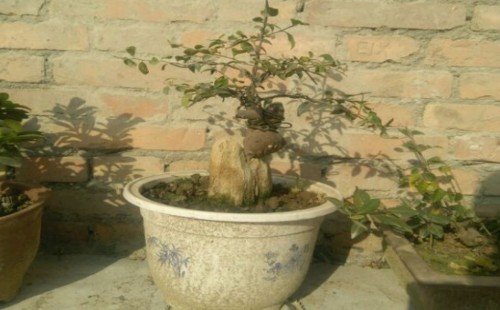How to attach stone to elm tree-the method of making bonsai with stone on elm tree
In the growing season of elm bonsai, there are often many new branches, and even a lot of overgrown branches, so we need to do a good pruning treatment in time to prevent the new branches from destroying the original beautiful shape of the bonsai. However, it often takes about 5 years from young elm to bonsai. In addition to using pruning means to make and improve its shape, we can also carry out stone-attached design for elm, so as to create a stone-attached bonsai for elm. But how do elms attach stones?
How to make an elm bonsai, often the bonsai should be selected according to the shape and potential of the tree to determine what kind of shape it is suitable to make. The common modeling styles are water-facing type, double-dry type or semi-cliff type and so on. The production of elm stone bonsai, generally in the first three years is the need for elm stocking, this is mainly to make the root system of elm can winding, full, hold on to the stone, or even fall into the cracks in the stone. Today, the editor will share with you the method of making bonsai with stone on elm trees.
First of all, all the materials and tools that may be needed to make the elm bonsai are prepared in advance, including flowerpots, soil, stones and elms. However, in order to fix the stone in the flowerpot and then make the stone-attached bonsai, we usually choose a flowerpot with holes in the bottom, then lay a layer of barbed wire in the basin, and then use the wire to pass through the holes in the bottom of the pot, including through the barbed wire.
The next thing we need to do is to attach stone to the elm and choose the appropriate style according to the design needs. The original then tied and fixed the elm and stone with the help of wire and thread. Then pour a layer of particle matrix into the basin and put the pre-bound elm and stone into the basin. Twist and bind the stones and elms with the wire of the pot and fix them in the flowerpot. Finally, the basin soil is loaded into the basin.
Attach stone to elm, generally use wire, thread and other tools to tie it to roughly shape. Then use a plaster on the outer layer of the bonsai to wrap the roots of the elm tightly with the stone. In general, in early autumn, we can remove the plaster that binds and wraps the roots and stones, wait for the opportunity to prune it, and finally release it. However, the watering of bonsai should be done well during stocking to avoid the phenomenon of poor growth of elm trees due to lack of water.
The watering of elm bonsai with stone generally adopts the method of "dry and wet", that is, the basin soil is watered in time after drying. However, due to the relatively high temperature in summer, which can generally reach more than 30 °C, not only the water consumption of elm is relatively large, but also the temperature is high and the weather is hot, and the evaporation of water is also very large, so in addition to watering, it is also necessary to spray more water on bonsai to cool down and keep humid. However, the second watering should be carried out in the morning and evening when the summer temperature is more than 30 °C. when the autumn temperature is below 20 °C, it can be watered once at about 4: 00 in the afternoon. when the winter temperature is below 10 °C, we should choose to water at noon when the temperature is relatively high, and the watering frequency should be strictly controlled.
Time: 2019-06-03 Click:
- Prev

How to fix the stone with stone bonsai
Stone bonsai is a perfect integration of stone and plant science. As a form of expression of potted plants, it can not only reflect the natural style, but also create a sense of beauty through integration. On the other hand, the stone bonsai is usually planted on the stone, mainly through the root system of the plant to grasp the stone wall.
- Next

How to attach stone to golden marbles-the method of making bonsai with golden marbles
The root system of the golden billiard tree is very developed, and the trailing ability is also very prominent. Wild golden marbles generally grow on very steep cliffs and are in an environment of lack of water and fertilizer for a long time, but they often maintain a good state of growth. People have to admire its indomitable vitality.
Related
- Fuxing push coffee new agricultural production and marketing class: lack of small-scale processing plants
- Jujube rice field leisure farm deep ploughing Yilan for five years to create a space for organic food and play
- Nongyu Farm-A trial of organic papaya for brave women with advanced technology
- Four points for attention in the prevention and control of diseases and insect pests of edible fungi
- How to add nutrient solution to Edible Fungi
- Is there any good way to control edible fungus mites?
- Open Inoculation Technology of Edible Fungi
- Is there any clever way to use fertilizer for edible fungus in winter?
- What agents are used to kill the pathogens of edible fungi in the mushroom shed?
- Rapid drying of Edible Fungi

